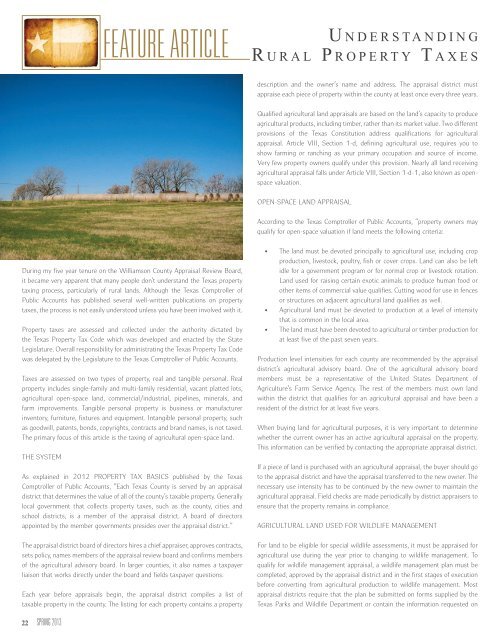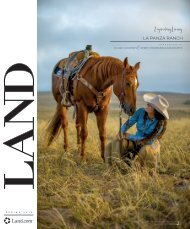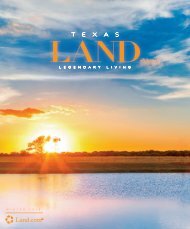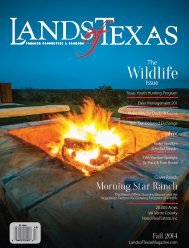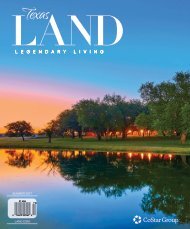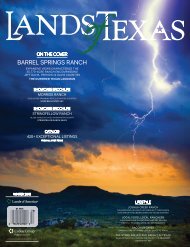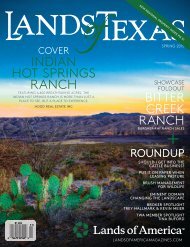You also want an ePaper? Increase the reach of your titles
YUMPU automatically turns print PDFs into web optimized ePapers that Google loves.
FEATURE ARTICLE<br />
U n d e r s t a n d i n g<br />
R u r a l P r o p e r t y T a x e s<br />
description and the owner’s name and address. The appraisal district must<br />
appraise each piece of property within the county at least once every three years.<br />
Qualified agricultural land appraisals are based on the land’s capacity to produce<br />
agricultural products, including timber, rather than its market value. Two different<br />
provisions of the <strong>Texas</strong> Constitution address qualifications for agricultural<br />
appraisal. Article VIII, Section 1-d, defining agricultural use, requires you to<br />
show farming or ranching as your primary occupation and source of income.<br />
Very few property owners qualify under this provision. Nearly all land receiving<br />
agricultural appraisal falls under Article VIII, Section 1-d-1, also known as openspace<br />
valuation.<br />
Open-space land appraisal<br />
According to the <strong>Texas</strong> Comptroller of Public Accounts, “property owners may<br />
qualify for open-space valuation if land meets the following criteria:<br />
During my five year tenure on the Williamson County Appraisal Review Board,<br />
it became very apparent that many people don’t understand the <strong>Texas</strong> property<br />
taxing process, particularly of rural lands. Although the <strong>Texas</strong> Comptroller of<br />
Public Accounts has published several well-written publications on property<br />
taxes, the process is not easily understood unless you have been involved with it.<br />
Property taxes are assessed and collected under the authority dictated by<br />
the <strong>Texas</strong> Property Tax Code which was developed and enacted by the State<br />
Legislature. Overall responsibility for administrating the <strong>Texas</strong> Property Tax Code<br />
was delegated by the Legislature to the <strong>Texas</strong> Comptroller of Public Accounts.<br />
Taxes are assessed on two types of property, real and tangible personal. Real<br />
property includes single-family and multi-family residential, vacant platted lots,<br />
agricultural open-space land, commercial/industrial, pipelines, minerals, and<br />
farm improvements. Tangible personal property is business or manufacturer<br />
inventory, furniture, fixtures and equipment. Intangible personal property, such<br />
as goodwill, patents, bonds, copyrights, contracts and brand names, is not taxed.<br />
The primary focus of this article is the taxing of agricultural open-space land.<br />
The system<br />
As explained in 2012 Property Tax Basics published by the <strong>Texas</strong><br />
Comptroller of Public Accounts, “Each <strong>Texas</strong> County is served by an appraisal<br />
district that determines the value of all of the county’s taxable property. Generally<br />
local government that collects property taxes, such as the county, cities and<br />
school districts, is a member of the appraisal district. A board of directors<br />
appointed by the member governments presides over the appraisal district.”<br />
The appraisal district board of directors hires a chief appraiser, approves contracts,<br />
sets policy, names members of the appraisal review board and confirms members<br />
of the agricultural advisory board. In larger counties, it also names a taxpayer<br />
liaison that works directly under the board and fields taxpayer questions.<br />
Each year before appraisals begin, the appraisal district compiles a list of<br />
taxable property in the county. The listing for each property contains a property<br />
• The land must be devoted principally to agricultural use, including crop<br />
production, livestock, poultry, fish or cover crops. Land can also be left<br />
idle for a government program or for normal crop or livestock rotation.<br />
Land used for raising certain exotic animals to produce human food or<br />
other items of commercial value qualifies. Cutting wood for use in fences<br />
or structures on adjacent agricultural land qualifies as well.<br />
• Agricultural land must be devoted to production at a level of intensity<br />
that is common in the local area.<br />
• The land must have been devoted to agricultural or timber production for<br />
at least five of the past seven years.<br />
Production level intensities for each county are recommended by the appraisal<br />
district’s agricultural advisory board. One of the agricultural advisory board<br />
members must be a representative of the United States Department of<br />
Agriculture’s Farm Service Agency. The rest of the members must own land<br />
within the district that qualifies for an agricultural appraisal and have been a<br />
resident of the district for at least five years.<br />
When buying land for agricultural purposes, it is very important to determine<br />
whether the current owner has an active agricultural appraisal on the property.<br />
This information can be verified by contacting the appropriate appraisal district.<br />
If a piece of land is purchased with an agricultural appraisal, the buyer should go<br />
to the appraisal district and have the appraisal transferred to the new owner. The<br />
necessary use intensity has to be continued by the new owner to maintain the<br />
agricultural appraisal. Field checks are made periodically by district appraisers to<br />
ensure that the property remains in compliance.<br />
AGRICULTURAL land used for wildlife management<br />
For land to be eligible for special wildlife assessments, it must be appraised for<br />
agricultural use during the year prior to changing to wildlife management. To<br />
qualify for wildlife management appraisal, a wildlife management plan must be<br />
completed, approved by the appraisal district and in the first stages of execution<br />
before converting from agricultural production to wildlife management. Most<br />
appraisal districts require that the plan be submitted on forms supplied by the<br />
<strong>Texas</strong> Parks and Wildlife Department or contain the information requested on<br />
22 SPRING <strong>2013</strong>


